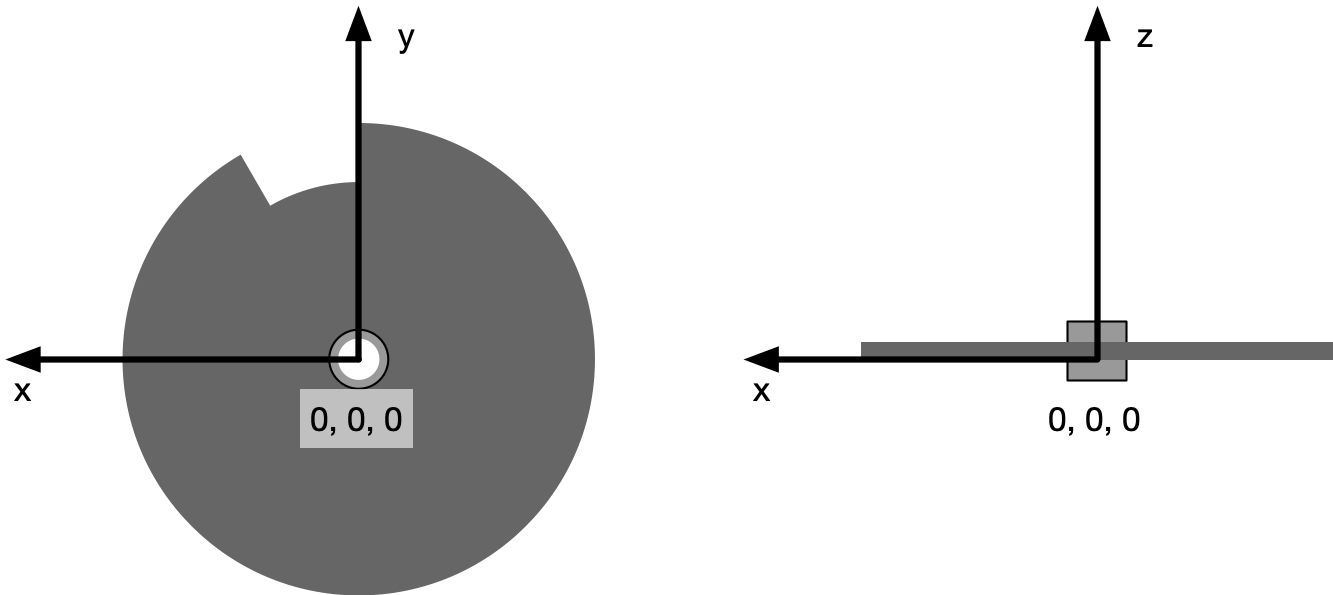3.3.1.73. NXdisk_chopper¶
Status:
base class, extends NXcomponent
Description:
A device blocking the beam in a temporal periodic pattern. ...
A device blocking the beam in a temporal periodic pattern.
A disk which blocks the beam but has one or more slits to periodically let neutrons through as the disk rotates. Often used in pairs, one NXdisk_chopper should be defined for each disk.
The rotation of the disk is commonly monitored by recording a timestamp for each full rotation of disk, by having a sensor in the stationary disk housing sensing when it is aligned with a feature (such as a magnet) on the disk. We refer to this below as the “top-dead-center signal”.
Angles and positive rotation speeds are measured in an anticlockwise direction when facing away from the source.
Symbols:
This symbol will be used below to coordinate datasets with the same shape.
n: Number of slits in the disk
- Groups cited:
Structure:
type: (optional) NX_CHAR
Type of the disk-chopper: only one from the enumerated list (match text exactl ...
Type of the disk-chopper: only one from the enumerated list (match text exactly)
Any of these values:
Chopper type single
contra_rotating_pair
synchro_pairrotation_speed: (optional) NX_FLOAT {units=NX_FREQUENCY}
Chopper rotation speed. Positive for anticlockwise rotation when ...
Chopper rotation speed. Positive for anticlockwise rotation when facing away from the source, negative otherwise.
slits: (optional) NX_INT
Number of slits
slit_angle: (optional) NX_FLOAT {units=NX_ANGLE}
Angular opening
pair_separation: (optional) NX_FLOAT {units=NX_LENGTH}
Disk spacing in direction of beam
slit_edges: (optional) NX_FLOAT (Rank: 1, Dimensions: [2n]) {units=NX_ANGLE}
Angle of each edge of every slit from the position of the ...
Angle of each edge of every slit from the position of the top-dead-center timestamp sensor, anticlockwise when facing away from the source. The first edge must be the opening edge of a slit, thus the last edge may have an angle greater than 360 degrees.
top_dead_center: (optional) NX_NUMBER {units=NX_TIME}
@start: (optional) NX_DATE_TIME
beam_position: (optional) NX_FLOAT {units=NX_ANGLE}
Angular separation of the center of the beam and the ...
Angular separation of the center of the beam and the top-dead-center timestamp sensor, anticlockwise when facing away from the source.
radius: (optional) NX_FLOAT {units=NX_LENGTH}
Radius of the disk
slit_height: (optional) NX_FLOAT {units=NX_LENGTH}
Total slit height
phase: (optional) NX_FLOAT {units=NX_ANGLE}
Chopper phase angle
delay: (optional) NX_NUMBER {units=NX_TIME}
Time difference between timing system t0 and chopper driving clock signal
ratio: (optional) NX_INT
Pulse reduction factor of this chopper in relation to other ...
Pulse reduction factor of this chopper in relation to other choppers/fastest pulse in the instrument
distance: (optional) NX_FLOAT {units=NX_LENGTH}
Effective distance to the origin. ...
Effective distance to the origin. Note, it is recommended to use NXtransformations instead.
wavelength_range: (optional) NX_FLOAT (Rank: 1, Dimensions: [2]) {units=NX_WAVELENGTH}
Low and high values of wavelength range transmitted
depends_on: (optional) NX_CHAR ⤆
The reference plane of the disk chopper includes the surface of the spinning d ...
The reference plane of the disk chopper includes the surface of the spinning disk which faces the source. The reference point in the x and y axis is the point on this surface which is the centre of the axle which the disk is spinning around. The reference plane is orthogonal to the z axis and its position is the reference point on that axis.
Note: This reference point in almost all practical cases is not where the beam passes though.

GEOMETRY: (optional) NXgeometry
DEPRECATED: Use the field depends_on and NXtransformations to position the chopper and NXoff_geometry to describe its shape instead
OFF_GEOMETRY: (optional) NXoff_geometry
This group describes the shape of the beam line component
Hypertext Anchors¶
List of hypertext anchors for all groups, fields, attributes, and links defined in this class.